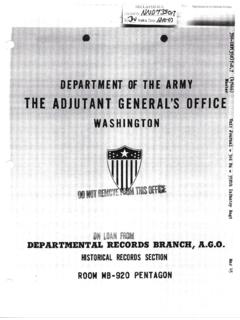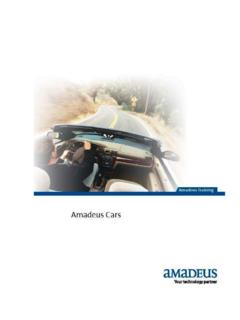Transcription of Long Term Oxygen Therapy (LTOT) - NLHEP
1 National Lung health education Term OxygenTherapy (LTOT)History, Scientific Foundations, andEmerging TechnologiesThomas L. Petty, W. McCoy, , RRTD ennis E. Doherty, Oxygen Consensus Conference RecommendationsHistorical HighlightsPage 2 Physiologic Responses to LTOT Page 3 Two Major Randomized Clinical TrialsPage 5 The British Medical Research Council Clinical TrialThe Nocturnal Oxygen Therapy Trial (NOTT)Other Benefits from OxygenPage 7 Oxygen Dosing (Liter Flow)Page 7 Prescribing CriteriaPage 8 Oxygen ToxicityPage 9 Oxygen SafetyPage 10A Re-Examination of the Nocturnal Oxygen Therapy Trials (NOTT)Page 10 Oxygen TechnologiesPage 15 Cost Effectiveness of LTOTPage 21 The National Lung health education Program ( NLHEP )Page 22 Appendix.
2 Recommendations of the Six Oxygen Consensus Conferences (2006, 1999, 1993, 1990, 1987, 1986)Page 24 ReferencesPage term Oxygen Therapy (LTOT) is well established as the standard of care for manypatients with chronic stable hypoxemia. Most studies have been done in ChronicObstructive Pulmonary Disease (COPD), but patients with other causes of chronichypoxemia and its consequences are also likely to benefit. Both the length and qualityof life are improved with LTOT used inside andoutside the home. It is believed thatincreased blood flow to central organs, made possible by increasing exercise withambulatory Oxygen , is the main reason for those benefits. Industry has continued to produce new ultra-light weight Oxygen systems, which cantruly be called ambulatory.
3 Low weight Oxygen concentrators are making oxygentravel more practical and realistic for patients who require Oxygen around the clock. Atthe very time that these advances are occurring, third party payors, mainly Medicare, arecontinuing to plan reductions in reimbursement for newer systems. A realisticreimbursement system is critical to the future of LTOT, which, involves the lives ofapproximately million original purpose of this monograph was to provide background for participants inthe Sixth Oxygen Conference held in Denver, Colorado in August 2005. (2006 RespCare51(5):519-525) The purpose of this booklet is to provide the important historical andscientific highlights for LTOT and to present a better understanding of the new life thatoccurs with booklet briefly presents the history of LTOT and the state of our knowledgeabout the scientific basis for LTOT.
4 Emerging technologies promise to make LTOT moreavailable and effective for the growing number of patients with a medical necessity forLTOT. Increased mobility is key to improving quality of records that Oxygen was firstdiscovered by Joseph Priestley on August 1,1774, when he obtained a colorless gas byheating red mercuric oxide. He recognized thatthe candle flame would burn brighter in whathe had termed dephlogisticated air. Hecaptured the gas in an inverted bell, and he andtwo mice were the first to breathe this pureair. He noted a light and easy feeling andremarked, who can tell but that in time thispure air may become a fashionable article inluxury. 1,2 Carl Wilhelm Scheele, a Swedishchemist, also discovered Oxygen , maybe asearly as s friend, AntoineLavoisier, successfully repeated Priestley soriginal experiment and named the newlydiscovered gas Oxygen .
5 Oxygen was first usedclinically in dental anesthesia as early as first recorded use of Oxygen , during thetreatment of acute bacterial pneumonia, was inYork, Pennsylvania, on March 6, 1885. Holtzapple produced Oxygen fromchlorate of potassium and black oxide ofmanganese by heating the chemicals in a largeglass cylinder with a flame from a lamp. Theresultant Oxygen was delivered via rubbertubing to the face of a young man who wasdying from pneumonia (presumably secondaryto the consequences of his hypoxemia). Afterseveral hours the crisis passed and the youngman nasal catheter first came to be used asa conduit for Oxygen Therapy at around theturn of the century. Other Oxygen deliverydevices were soon to John S.
6 Haldane s expedition toPike s Peak in 1913, he concluded in his landmarkarticle in the British Medical Journalin 1919 that partial anoxia means not a mere slowing downof life, but progressive, and perhaps irreparabledamage to human structure. 6 Haldane predictedthat Oxygen would soon be used in Barach was the first to systematicallyemploy Oxygen for the treatment of modified an Oxygen tent,originally invented by Leonard ,8 Barachwas also interested in the role of Oxygen andrelief of dyspnea during exercise. In 1958 hedeveloped a small transfillable Oxygen cylindersuitable for use during exercise (Figure 1).Cotes and Gilson also gave Oxygen toambulatory patients from small portable high-pressure cylinders in the United Kingdom (UK).
7 Cotes reported on increased walking time andimproved arterial Oxygen saturation with theuse of supplemental Oxygen during 1955 approximately 30% of all chemists in Wales and Monmouthshire (population ) were supplying Oxygen by prescription,at that time, to an astonishing 860 cylinders were the only modalityutilized for the delivery of Oxygen Therapy inthat era. Apparently this practice did notcontinue in the UK, or else it is not recorded inthe literature. Barach died in 1976, and hadbeen an inspiration to many who began tolearn the values of LTOT and developinnovative new Oxygen Historical HighlightsFigure 1. Cartoon diagram by Dr. Barach emphasizingthe importance of walking with ambulatory first liquid transfillable systems becameavailable commercially from the LindeCorporation in 1965.
8 The Denver Groupenrolled 6 patients in a study to investigate theutility of supplemental Oxygen on the basis ofclinical evidence of severe pulmonaryhypertension, erythrocytosis, hematocrit >55%, and markedly reduced six patients were admittedto a clinical research unit for the purpose ofstabilization for one month, when no oxygenwas used. During stabilization, theadministration of bronchodilators, diuretics,cardiac glycosides when indicated, andtreatment of any evidence of infection wasinstituted and provided for clinical were encouraged to eat a high-caloriediet and exercised systematically each day toimprove physical conditioning and to increaseexercise capability. At the end of this controlmonth, cardiac catheterization was done tomeasure pulmonary artery pressure, cardiacoutput, and pulmonary vascular red cell massdeterminations were also During thesecond month, the patients were maintained onthe same diet and maintenance medications,and Oxygen was administered by nasal canulaat a flow sufficient to bring Oxygen saturationabove 90% during rest and exercise.
9 In allpatients, this required 1-3 L/min, averaging 2L/min. At the end of one month, cardiaccatheterization and red cell mass studies wererepeated. Marked reductions in pulmonaryartery pressure and pulmonary vascular resistance were observed in 4 of the 6 red cell mass improved in 4 of the sixpatients in whom both determinations could beaccomplished. The most dramatic outcome wasthe markedly increased exercise tolerance inthese patients (Figure 2).The first of these Oxygen study patientsbecame our first home care patient in of his quality of life and homefunctioning have been reported on numerousoccasions in previous writing by one of us(TLP).11At approximately the same time, an almostidentical study was done in Birmingham,England, which resulted in exactly the sameconclusions about hemodynamic improvementsand red cell mass in response to supplementaloxygen Formal exercise studies werenot conducted by the Birmingham group,largely because cumbersome Physiologic Responses to LTOTF igure 2.
10 Improvement in exercise tolerance in twopatients trained at level walk. Note the slow changeduring the control month, and the marked rapid risein tolerance during the Oxygen month. and the patients initials. Temporary decrease in sexercise tolerance during the Oxygen month was dueto an episode of acute were used. However, these were usedwith a trolley, so some degree of ambulationwas possible while pushing the oxygencylinders. Although no accounts of exercisetolerance are reported, the authors remark, Exercise tolerance increased remarkably ..even though there was no specific program oftraining. In 1968 we reported on 20 patients withadvanced chronic obstructive pulmonary disease(COPD) who received continuous ambulatoryoxygen Therapy from a liquid Oxygen portablesystem for up to 18 that article weshowed crude anecdotal evidence ofimprovement in cor pulmonale, with evidenceof improvement in electro-cardiograph tracingsand in the cardiac silhouette, with resolution inright ventricular size as a result of 6 months ofoxygen administration.






